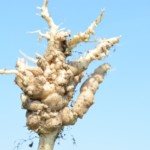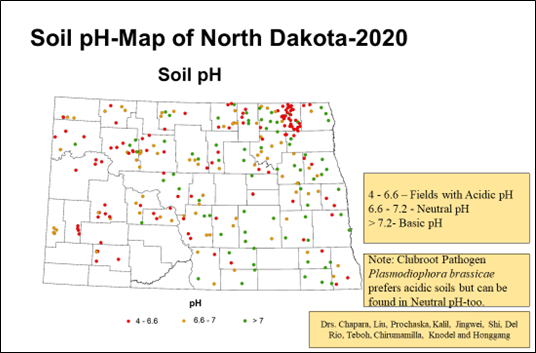
 By Venkata Chapara, Ph.D.
By Venkata Chapara, Ph.D.
Clubroot disease on canola is caused by Plasmodiophora brassicae, a soil-borne pathogen that moves from field to field on both agricultural and non-agricultural equipment. In simple words, it moves from whatever moves the soil. With an objective to determine the extent of disease spread in North Dakota, clubroot incidence and prevalence has been monitored in annual surveys for six years by examining canola roots for clubs/galls. These surveys have been funded by the Northern Canola Growers Association, Northern Canola Research Program (USDA/NIFA), SBARE and NDCP Product Harmonization Board.
Results indicate that clubroot on canola is so far endemic to Cavalier County since its first identification in North Dakota via visual galls on roots. The highest number of canola fields with clubroot incidence was recorded in 2018 (31% of the canola fields that were surveyed were found with galls on roots) and the lowest (5%) in 2021 (Figure 1).
Figure 1: Fields with visual clubroot galls in the survey done from 2013 to 2021 for prevalence of clubroot in Cavalier County, North Dakota.

Even though visual galls on roots were found only in the canola crop that was grown in Cavalier County, P. brassicae resting spore DNA was found in soil samples that were collected from fields in 26 of 44 counties surveyed in 2020 (Figure 2) and 21 of 48 counties in 2021. Quantified resting spores of P. brassicae from those samples ranged from 500 to 40 million spores per gram of soil.
Figure 2: Map of counties in North Dakota indicating Plasmodiophora brassicae (the clubroot pathogen) resting spores detected by molecular assays in the soil samples submitted in 2020.

Note: The green dot indicates zero, yellow dot indicates range of 1-80,000 and the red dot indicates more than 80,000 resting spores per gram of soil.
Lack of visible galls in the surveyed fields that had resting spore DNA indicates that either the spore population did not reach the required amount per gram of acidic soil to show galls or the soil is basic with a pH above 7 (Figure 3). In general, clubroot infections are expressed on canola plants where soil resting spore population is about 80,000 spores per gram of soil (Canadian Research).
Figure 3: Map of counties in North Dakota indicating pH ranges detected by soil assays in the soil samples submitted in 2020.

Note: The green dot indicates pH above 7, yellow dot indicates pH range of 6.6 – 7.0 and the red dot indicates 4 – 6.6 acidic of soil.
 These results indicate a need for continuous annual monitoring. Clubroot initial infections start in a field as small patches and later spread all over, mostly due to in-field cultural activities. Identifying and treating those patches plays an important role in the management of clubroot. Treating the patches with soil amendments such as beet lime at a rate of 15 t/ha (by product in sugar beet industry) has given considerable clubroot control under field conditions when a canola cultivar susceptible to clubroot was planted.
These results indicate a need for continuous annual monitoring. Clubroot initial infections start in a field as small patches and later spread all over, mostly due to in-field cultural activities. Identifying and treating those patches plays an important role in the management of clubroot. Treating the patches with soil amendments such as beet lime at a rate of 15 t/ha (by product in sugar beet industry) has given considerable clubroot control under field conditions when a canola cultivar susceptible to clubroot was planted.
The amount of resting spores of P. brassicae in soils can be a threat to the canola crop if proper attention is not given to longer crop rotations (one in three years). In addition, growers should consider planting a clubroot-resistant canola variety in endemic areas and follow proper equipment sanitation. Cleaning equipment thoroughly after working in a clubroot-infected field is highly recommended since the primary mechanism of spread between fields is the movement of infested soil on farm equipment.
Venkata Chapata, Ph.D., is associate agricultural experiment station specialist and plant pathologist at Langdon Research Extension Center of North Dakota State University in Langdon, N.D.